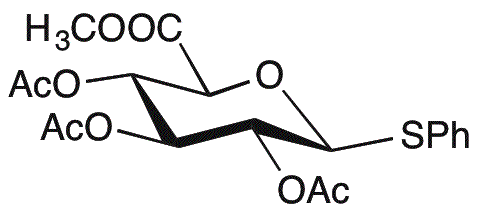Methyl (Phenyl 2,3,4-tri-O-acetyl-1-thio-b-D-glucopyranosid)uronate is widely utilized in research focused on:
- Drug Development: This compound serves as a valuable intermediate in synthesizing glycosylated drugs, enhancing their bioavailability and therapeutic efficacy.
- Biotechnology: It is used in the production of glycoproteins, which are essential for various biopharmaceutical applications, including vaccine development and antibody production.
- Food Industry: The compound can be applied in food science for developing flavoring agents and preservatives, improving the shelf life and taste of products.
- Cosmetics: Its properties make it suitable for formulating skin care products, where it can enhance moisture retention and skin barrier function.
- Research Applications: It is frequently employed in carbohydrate chemistry studies, aiding researchers in understanding glycosidic bond formation and reactivity.
General Information
Properties
Safety and Regulations
Applications
Methyl (Phenyl 2,3,4-tri-O-acetyl-1-thio-b-D-glucopyranosid)uronate is widely utilized in research focused on:
- Drug Development: This compound serves as a valuable intermediate in synthesizing glycosylated drugs, enhancing their bioavailability and therapeutic efficacy.
- Biotechnology: It is used in the production of glycoproteins, which are essential for various biopharmaceutical applications, including vaccine development and antibody production.
- Food Industry: The compound can be applied in food science for developing flavoring agents and preservatives, improving the shelf life and taste of products.
- Cosmetics: Its properties make it suitable for formulating skin care products, where it can enhance moisture retention and skin barrier function.
- Research Applications: It is frequently employed in carbohydrate chemistry studies, aiding researchers in understanding glycosidic bond formation and reactivity.
Documents
Safety Data Sheets (SDS)
The SDS provides comprehensive safety information on handling, storage, and disposal of the product.
Product Specification (PS)
The PS provides a comprehensive breakdown of the product’s properties, including chemical composition, physical state, purity, and storage requirements. It also details acceptable quality ranges and the product's intended applications.
Certificates of Analysis (COA)
Search for Certificates of Analysis (COA) by entering the products Lot Number. Lot and Batch Numbers can be found on a product’s label following the words ‘Lot’ or ‘Batch’.
Numéro de catalogue
Numéro de lot/série
Certificates Of Origin (COO)
This COO confirms the country where the product was manufactured, and also details the materials and components used in it and whether it is derived from natural, synthetic, or other specific sources. This certificate may be required for customs, trade, and regulatory compliance.
Numéro de catalogue
Numéro de lot/série
Safety Data Sheets (SDS)
The SDS provides comprehensive safety information on handling, storage, and disposal of the product.
DownloadProduct Specification (PS)
The PS provides a comprehensive breakdown of the product’s properties, including chemical composition, physical state, purity, and storage requirements. It also details acceptable quality ranges and the product's intended applications.
DownloadCertificates of Analysis (COA)
Search for Certificates of Analysis (COA) by entering the products Lot Number. Lot and Batch Numbers can be found on a product’s label following the words ‘Lot’ or ‘Batch’.
Numéro de catalogue
Numéro de lot/série
Certificates Of Origin (COO)
This COO confirms the country where the product was manufactured, and also details the materials and components used in it and whether it is derived from natural, synthetic, or other specific sources. This certificate may be required for customs, trade, and regulatory compliance.

